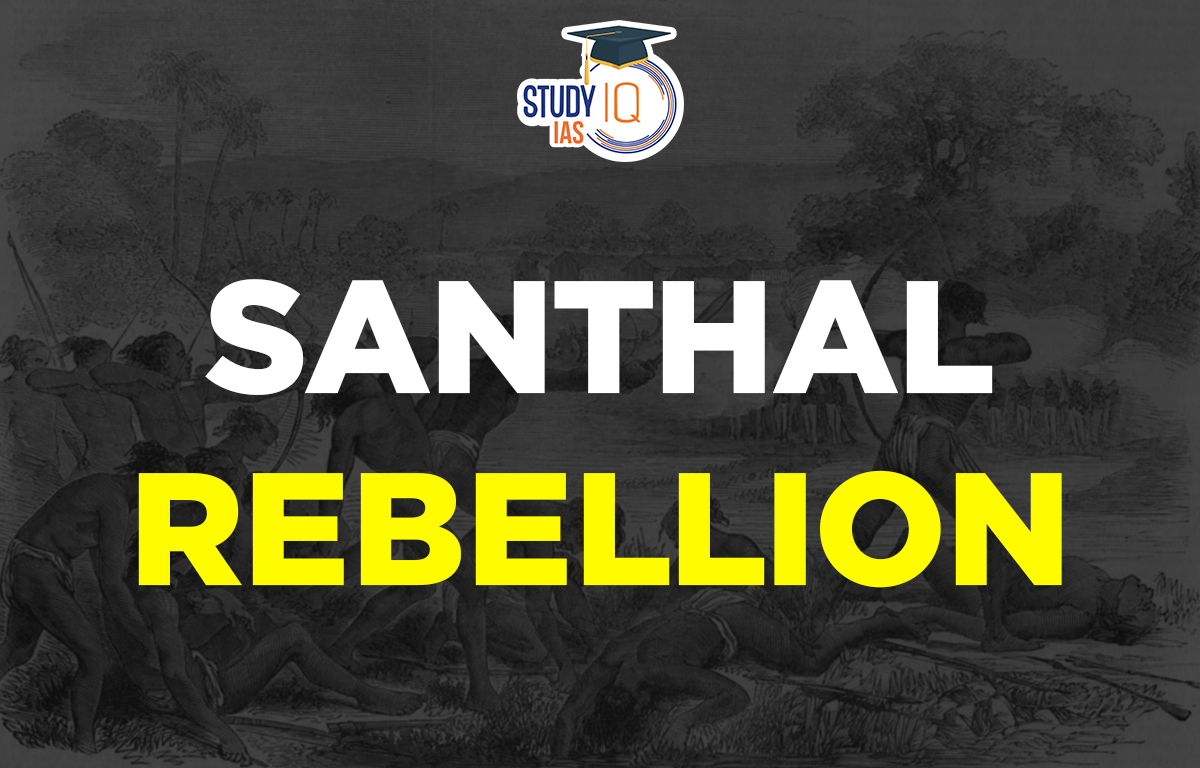Table of Contents
The Santhal Rebellion, also known as the Santhal Hool, was a native uprising in 1855-1856 by the Santhal tribal community against the oppressive practices of the British colonial authorities and zamindars (landlords) in the present-day states of Jharkhand, Bihar, and West Bengal in India. This rebellion is one of the earliest and most significant tribal revolts against colonial rule in India.
Who were the Santhals?
- Santhals were agricultural people living in the Rajmahal Hills of Bihar.
- The British asked them to clear forests for agriculture to increase revenue.
- In 1832, Damin-i-Koh, or Santal Pargana, was created as a designated area for Santhals.
- Over time, the British began exploiting the Santhals, leading to severe oppression and exploitation.
Background to the Santhal Revolt (1855 – 56)
The Santhal Revolt was a significant uprising in mid-19th century India. The Santhals, a tribal community residing in present-day Jharkhand and West Bengal, faced oppression and exploitation by moneylenders, landlords, and British colonial authorities.
The revolt began in 1855 under the leadership of brothers Sidhu and Kanhu, who rallied the Santhal community against unjust policies and excessive taxation. The Santhals aimed to regain their land rights, abolish oppressive systems, and establish a self-governing society.
The revolt spread quickly, with the Santhals attacking symbols of authority such as police stations and British-owned properties. However, the British responded with force, leading to violent conflict. Despite their valiant efforts, the Santhals were eventually suppressed by the British army in 1856. Many Santhals lost their lives, and the revolt was crushed. However, the uprising highlighted the grievances of indigenous communities and laid the foundation for future movements demanding land rights and social justice.
Santhal Rebellion Uprising
The rebellion was led by four brothers, Sidhu, Kanhu, Chand, and Bhairav Murmu, who mobilized the Santhal tribes against the exploitative practices imposed by the British and their agents. The Santhals, who were primarily agriculturalists, were subjected to severe economic exploitation and social oppression by the British revenue policies and the corrupt practices of local landlords and moneylenders.
Santhal Rebellion Causes
- Economic Exploitation: The Santhals were burdened with heavy taxes and subjected to unfair practices by landlords and moneylenders, leading to severe indebtedness.
- Social Oppression: The Santhals faced discrimination and were often treated unfairly by the local authorities and landlords.
- Land Alienation: The Santhals’ lands were forcibly taken over by the landlords and moneylenders, leading to a loss of their traditional livelihoods.
- British Revenue Policies: The introduction of new revenue systems by the British exacerbated the economic hardships faced by the Santhals.
Events in Santhal Rebellion
- Initial Mobilization: In June 1855, the Santhal leaders Sidhu and Kanhu held a large gathering at Bhognadih, where they declared their intention to fight against the oppressive practices and restore their rights.
- Widespread Revolt: The rebellion quickly spread across the Santhal Parganas region, with thousands of Santhals joining the uprising. They attacked police stations, railway constructions, and the properties of landlords and moneylenders.
- British Response: The British authorities responded with military force, deploying troops to suppress the rebellion. Despite their limited resources, the Santhals fought bravely against the well-armed British forces.
- Suppression: By the end of 1856, the British had managed to suppress the rebellion through brutal measures, including mass executions and destruction of Santhal villages.
Significance of Santhal Rebellion
- Resistance to Colonial Rule: The Santhal Rebellion is a significant example of tribal resistance to British colonial rule and exploitation in India.
- Awareness of Tribal Rights: The rebellion highlighted the plight of the tribal communities and brought their issues to the forefront, eventually leading to policy changes.
- Inspiration for Future Movements: The courage and determination of the Santhals inspired future generations and other tribal communities to stand up against oppression.
- Creation of Santhal Parganas: In recognition of the Santhal rebellion, the British established the Santhal Parganas division to address the grievances of the Santhals and provide them with some degree of autonomy.
Facts about Santhal Rebellion for UPSC Prelims
- Who were the Santhals? Agricultural People
- Original Occupation: Hunting, fishing; later turned to settled agriculture due to British influence.
- Location: Rajmahal Hills
- Start of Rebellion: 1855
- Leaders: Four Brothers – Sidhu, Kanhu, Chand, and Bhairav


 Desert Climate, Distribution, Climatic C...
Desert Climate, Distribution, Climatic C...
 Deserts of India Map, Features of Thar D...
Deserts of India Map, Features of Thar D...
 Maharashtra’s Mendrachi Vancharai Syst...
Maharashtra’s Mendrachi Vancharai Syst...





















